Mental fatigue can significantly hinder cognitive performance and productivity. This article explores key tests like the NASA Task Load Index and Fatigue Severity Scale, identifies common indicators such as decreased attention and slower reaction times, and examines the overall impact on performance. Understanding these aspects is crucial for effective management in high-demand environments. Regular assessments can help mitigate the effects of mental fatigue and enhance decision-making capabilities.
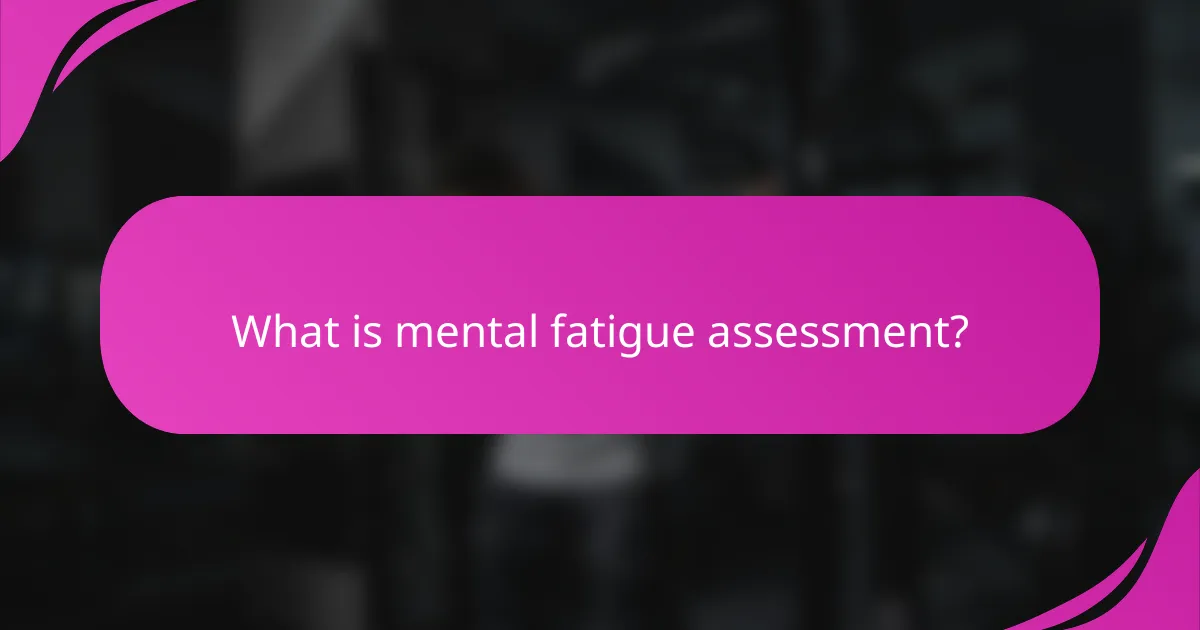
What is mental fatigue assessment?
Mental fatigue assessment evaluates cognitive decline due to prolonged mental activity. Key tests include the NASA Task Load Index and the Fatigue Severity Scale, which measure perceived workload and fatigue levels. Indicators of mental fatigue encompass decreased attention, slower reaction times, and impaired decision-making. Performance impact can manifest as reduced productivity and increased errors, highlighting the importance of regular assessments in high-demand environments.
How does mental fatigue differ from physical fatigue?
Mental fatigue primarily affects cognitive functions, while physical fatigue impacts bodily strength. Mental fatigue can lead to decreased concentration, slower reaction times, and impaired decision-making. In contrast, physical fatigue results in reduced muscle performance and endurance. Both types of fatigue can influence overall performance, but they manifest through different symptoms and recovery needs. Mental fatigue often requires rest and mental breaks, while physical fatigue may necessitate physical recovery and nutrition.
Why is assessing mental fatigue important for performance?
Assessing mental fatigue is crucial for optimizing performance. It directly influences cognitive functions, decision-making, and physical endurance. Mental fatigue can impair focus and reaction times, leading to decreased productivity and increased error rates. Regular assessments help identify fatigue levels, enabling timely interventions. For instance, utilizing standardized tests can quantify mental fatigue, guiding adjustments in workload and recovery strategies. Understanding these dynamics is essential for athletes and professionals aiming to maintain peak performance.
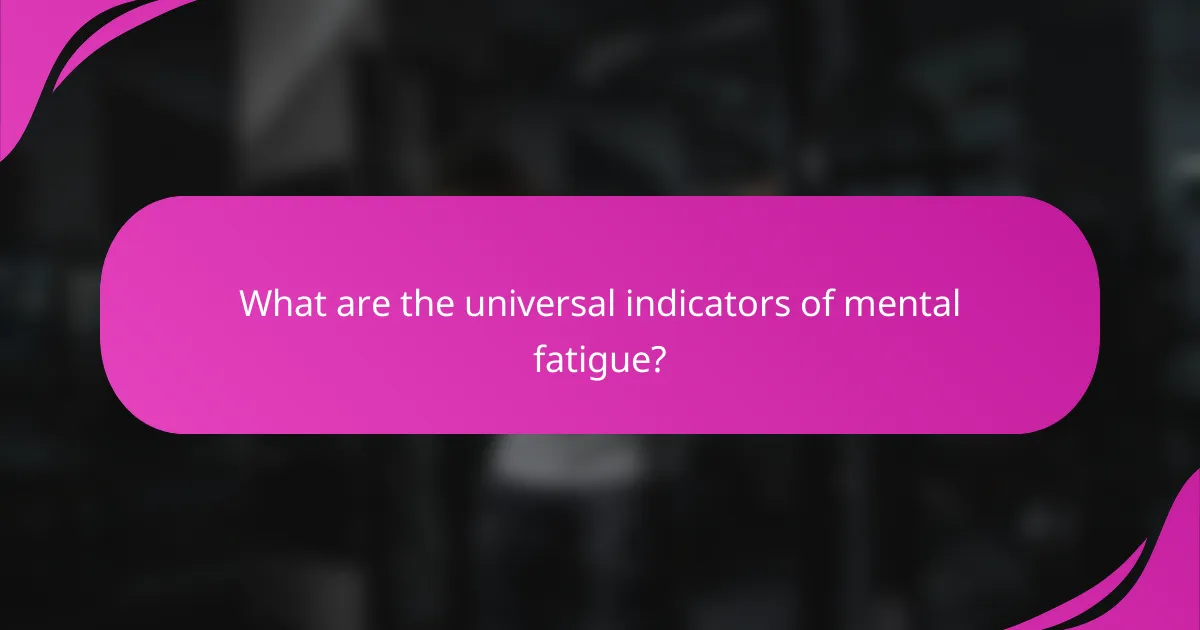
What are the universal indicators of mental fatigue?
Common indicators of mental fatigue include reduced attention span, increased irritability, difficulty concentrating, and slower reaction times. These symptoms can significantly impact overall performance and daily functioning. Recognizing these signs early can help in managing mental fatigue effectively.
What cognitive tests are used to assess mental fatigue?
Cognitive tests used to assess mental fatigue include various standardized assessments that measure attention, memory, and processing speed. Common tests are the Stroop Test, the Continuous Performance Test, and the Mental Fatigue Scale. These tests evaluate how mental fatigue impacts cognitive performance, revealing decreased attention and slower reaction times.
How does self-reporting contribute to mental fatigue assessment?
Self-reporting is crucial for mental fatigue assessment as it provides subjective insights into an individual’s experience. This method captures personal perceptions of fatigue, enabling a more nuanced understanding of its impact on performance. Studies show that self-reported fatigue correlates with objective measures, enhancing assessment accuracy. Additionally, self-reporting can reveal unique attributes of mental fatigue, such as emotional distress or cognitive overload, which are often overlooked in standardized tests.
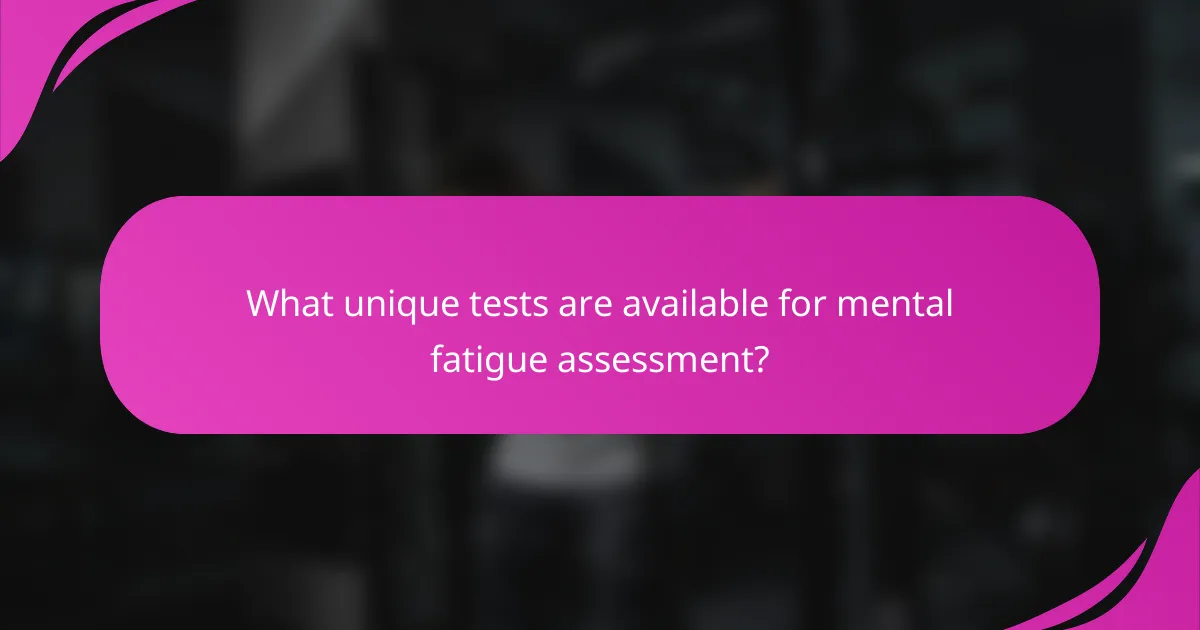
What unique tests are available for mental fatigue assessment?
Mental fatigue assessment includes unique tests like the Psychomotor Vigilance Test, Multi-Attribute Task Battery, and the Fatigue Scale. These tests measure reaction times and cognitive performance, indicating mental fatigue levels. For instance, the Psychomotor Vigilance Test evaluates sustained attention and response speed, while the Multi-Attribute Task Battery assesses multitasking abilities under fatigue. These assessments provide insights into how mental fatigue impacts performance and decision-making.
How does the Stroop test measure mental fatigue?
The Stroop test measures mental fatigue by assessing cognitive processing speed and interference. It requires participants to name the color of ink used for words that may spell out different colors. Increased mental fatigue slows reaction times and increases errors, indicating diminished cognitive resources. Research shows that performance on the Stroop test declines with higher levels of mental fatigue, revealing the impact on attention and executive function. This makes it a valuable tool for evaluating cognitive load and fatigue levels.
What role does the NASA Task Load Index play in assessment?
The NASA Task Load Index (TLX) is crucial for assessing mental fatigue. It evaluates perceived workload across six dimensions, providing insights into cognitive strain. This assessment helps identify performance impacts by linking workload to fatigue levels, thus guiding interventions to enhance efficiency. The TLX’s unique ability to quantify subjective experiences makes it a valuable tool in various fields, including aviation and healthcare.
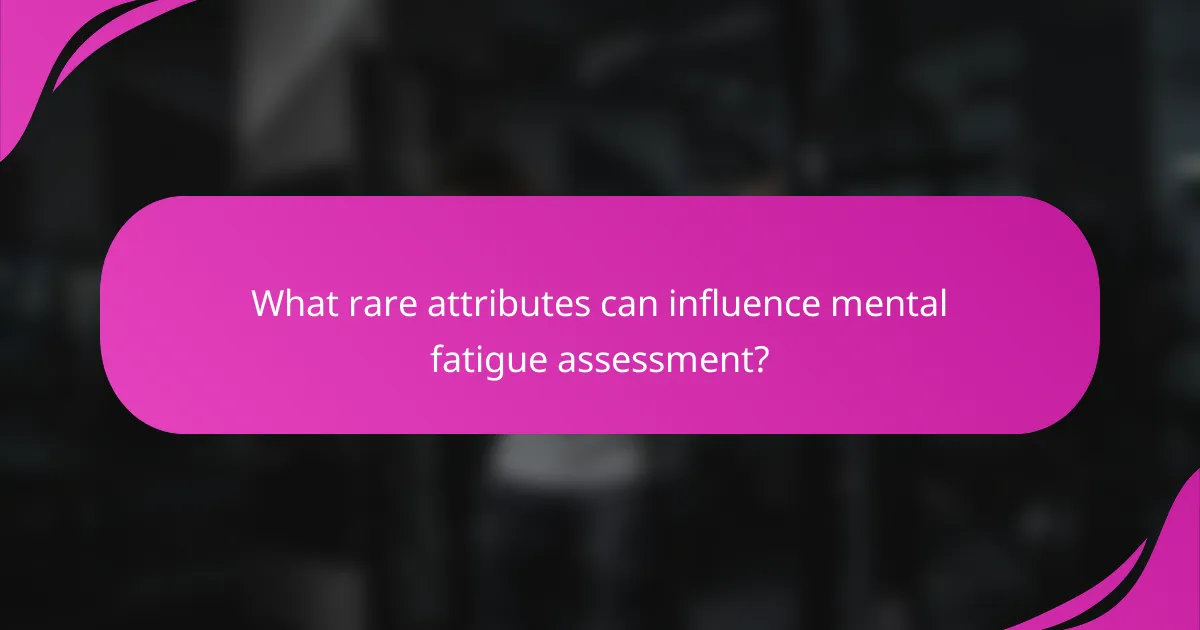
What rare attributes can influence mental fatigue assessment?
Rare attributes that can influence mental fatigue assessment include individual cognitive resilience, unique stress response patterns, and atypical sensory processing. These factors can significantly impact how mental fatigue is perceived and measured. Understanding these rare attributes enables more tailored assessments and interventions for individuals experiencing mental fatigue.
How do individual differences affect mental fatigue perception?
Individual differences significantly influence mental fatigue perception. Factors such as personality traits, cognitive styles, and emotional regulation impact how individuals experience and report mental fatigue. For instance, extroverted individuals may perceive mental fatigue differently than introverted ones, potentially due to their varying engagement levels in social situations. Moreover, those with higher resilience often report lower levels of mental fatigue, demonstrating a unique attribute that enhances their coping mechanisms. Understanding these differences is crucial for tailoring mental fatigue assessments and interventions to individual needs.
What environmental factors can impact mental fatigue levels?
Environmental factors such as noise, lighting, and air quality significantly impact mental fatigue levels. Poor air quality can lead to decreased cognitive function, while inadequate lighting may strain the eyes, exacerbating fatigue. Noise pollution disrupts concentration, further intensifying mental exhaustion. Studies indicate that environments with natural light and fresh air enhance mental clarity and reduce fatigue symptoms.
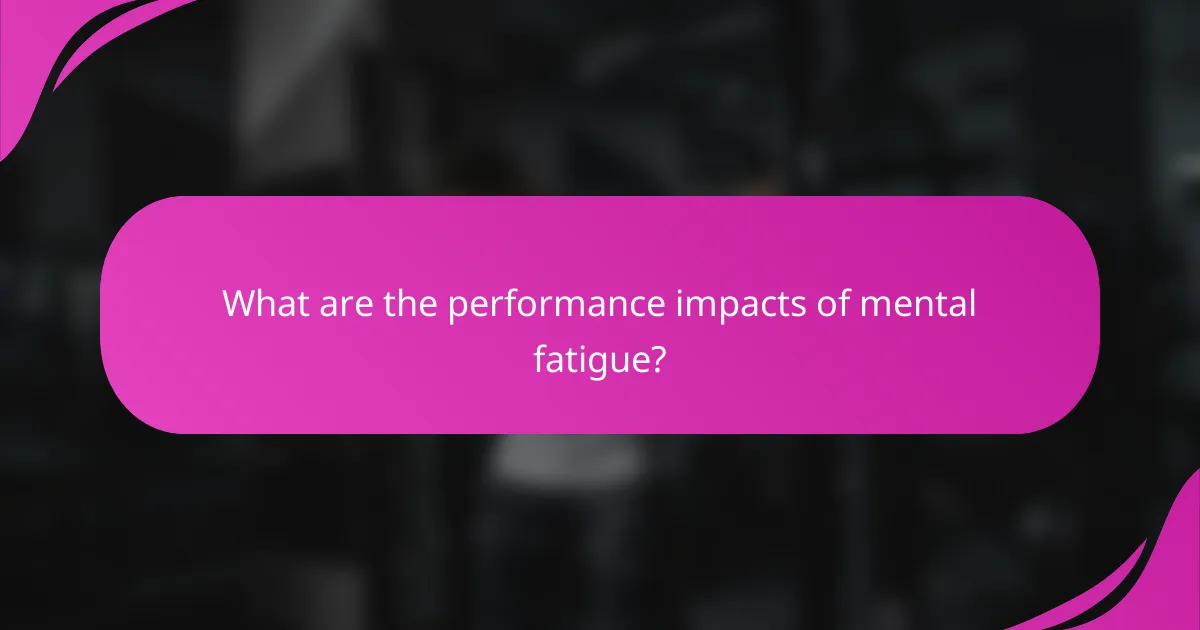
What are the performance impacts of mental fatigue?
Mental fatigue significantly impairs cognitive performance, reducing attention, decision-making, and reaction times. Studies indicate that prolonged mental fatigue can lead to a 30% decrease in productivity. Key indicators include decreased motivation and increased errors. Addressing mental fatigue through breaks and proper workload management can enhance overall performance.
How does mental fatigue affect decision-making abilities?
Mental fatigue significantly impairs decision-making abilities by reducing cognitive resources and increasing errors. This state leads to slower processing speeds and diminished attention, making individuals more prone to impulsive choices. Research indicates that mental fatigue can result in a 20% decline in performance on complex tasks. As a result, the quality of decisions suffers, impacting both personal and professional outcomes. Effective management of mental fatigue is essential for optimal decision-making.
What are the long-term consequences of untreated mental fatigue?
Untreated mental fatigue can lead to chronic stress, reduced cognitive function, and emotional instability. Long-term consequences include persistent fatigue, decreased productivity, and increased risk of mental health disorders such as anxiety and depression. Individuals may experience impaired decision-making and memory issues, affecting personal and professional relationships. Over time, these effects can contribute to physical health problems, including cardiovascular issues and weakened immune response. Addressing mental fatigue early is essential for maintaining overall well-being and performance.
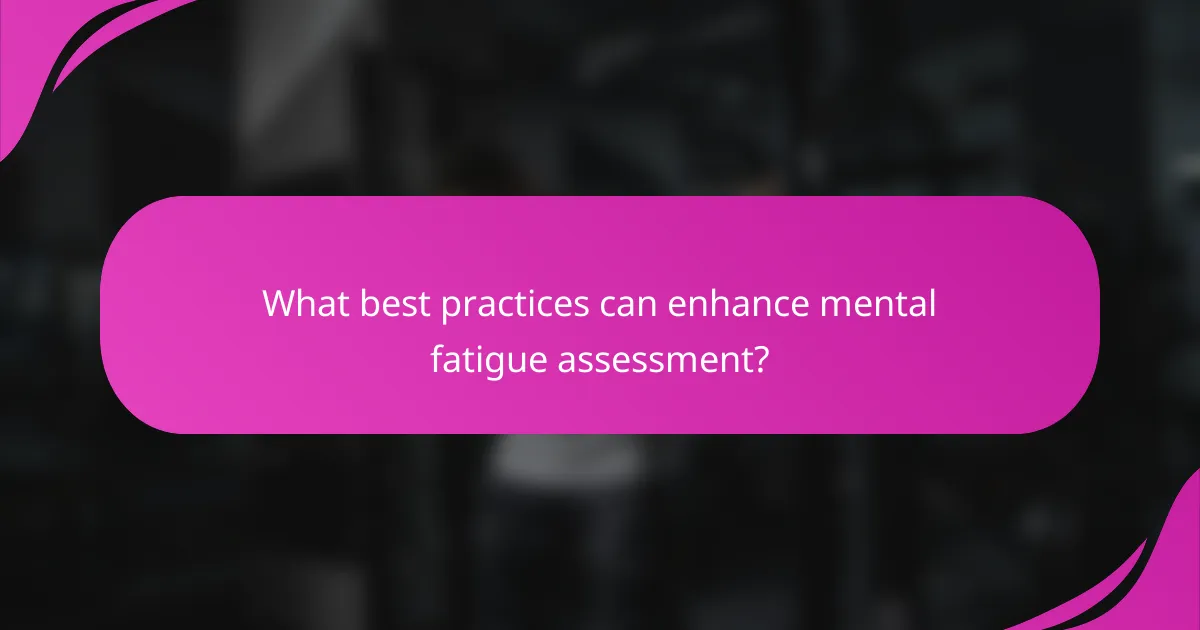
What best practices can enhance mental fatigue assessment?
To enhance mental fatigue assessment, utilize standardized tests, track performance indicators, and incorporate subjective feedback. Regular monitoring of cognitive load and environmental factors can provide deeper insights into mental fatigue levels. Employing validated questionnaires can also help identify unique fatigue patterns.
How can regular assessments improve workplace productivity?
Regular assessments of mental fatigue significantly enhance workplace productivity by identifying performance-impacting indicators. These assessments help in recognizing when employees are overworked or stressed, allowing for timely interventions. For instance, implementing regular fatigue assessments can reduce errors and improve decision-making. A study found that organizations with routine mental fatigue evaluations saw a 20% increase in overall productivity. By addressing mental fatigue, companies can foster a healthier work environment, leading to sustained employee engagement and output.
What common mistakes should be avoided in mental fatigue assessment?
Avoiding common mistakes in mental fatigue assessment is crucial for accurate evaluation. Key errors include neglecting individual variability, using inappropriate tests, and failing to consider environmental factors. Additionally, overlooking emotional and psychological influences can skew results. Inadequate interpretation of data can lead to misdiagnosis or ineffective interventions. Ensuring a comprehensive approach enhances the reliability of assessments.
How can assessments be tailored to specific roles or industries?
Tailoring mental fatigue assessments to specific roles or industries enhances relevance and accuracy. Customization involves aligning assessment methods with job demands and stressors unique to each field.
For example, in high-stakes environments like healthcare, assessments may focus on decision-making under pressure and emotional resilience. In contrast, creative industries might prioritize assessments related to cognitive flexibility and innovation.
Integrating role-specific indicators, such as workload patterns and environmental factors, further refines the assessment process. This approach ensures that evaluations genuinely reflect the mental fatigue experienced in particular job contexts, leading to more effective interventions.
What strategies can be implemented to mitigate mental fatigue?
To mitigate mental fatigue, implement strategies such as regular breaks, mindfulness practices, and balanced nutrition. These approaches enhance cognitive function and maintain energy levels.
1. Schedule short breaks every hour to recharge focus.
2. Practice mindfulness techniques like meditation to reduce stress.
3. Maintain a balanced diet rich in fruits, vegetables, and whole grains to support brain health.
4. Stay hydrated, as dehydration can impair cognitive performance.
5. Prioritize sleep, ensuring adequate rest for optimal mental clarity.
6. Engage in physical activity to boost mood and energy levels.